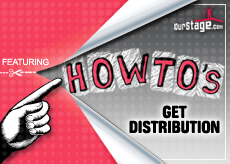HOW TO GET DISTRIBUTION
posted in: Music News
 You spent months recording your CD, mixing and mastering it, deciding on artwork and sending it off to production. And there it sits, with 4,999 of its friends, piled in boxes on your apartment floor gathering dust. What you need is some distribution. And finding the right distributor will require some tenacity and gumption. To give you a general idea of what the world of distribution looks like, here are the main players:
You spent months recording your CD, mixing and mastering it, deciding on artwork and sending it off to production. And there it sits, with 4,999 of its friends, piled in boxes on your apartment floor gathering dust. What you need is some distribution. And finding the right distributor will require some tenacity and gumption. To give you a general idea of what the world of distribution looks like, here are the main players:
¢ Major music distributors. These big-wigs, such as Sony-BMG Distribution, Capitol-EMI Distribution and UNI Distribution, are bedfellows of the majors and focus exclusively on them.
¢ Independent distributors. These distributors partner with independent record labels, and will often form alliances with other indies to expand their reach outside their region. An example of this would be the Alternative Distribution Alliance.
¢ Rack-jobbers. These ridiculously named distributors buy music and establish outlets of their own to sell it, usually kiosks and displays in department stores.
¢ International distributors. The jetsetting bunch, who market the records internationally and work for both major and independent labels. The largest one here in the states is E1 Entertainment.
¢ Digital distributors. These invisible ninjas supply records to online music merchants such as iTunes and Amazon, dealing in both MP3 and CD sales. The three major digital distributors are CDBaby, Nimbit and Tunecore.
While independent record shops staffed by earnest music nerds are a romantic ideal for many musicians, they’re unfortunately a dying breed. These days most physical record stores are actually just music aisles in places like Target, Best Buy and Wal-Mart. More and more, fans are turning to online stores to buy their music. That being the case, most music distributors cater strongly to the digital side of retail.
If you’re determined to see your music in the $10 bin at Target, but are an unsigned artist, you’ll want to research distributors who don’t go require label representation. This will be a challenge in and of itself, but if you find one, you’ll need to present them with a flawless press kit that demonstrates your saleability and a solid marketing plan that includes your Suggested Retail Price, or SRP. Most distributors will take a 40-60% cut of your SRP.
If you’re currently on a label, you probably don’t have to worry about distribution. Typically a distributor will partner with a label and front the manufacturing costs of the CD, then bill the label out of sales of that CD. Think of it as large-scale consignment.
However, because of the growing consumer trend towards online retailers, and the ease of securing a digital distributor without label representation, we recommend you focus your efforts solely on digital marketing of your music. Digital distribution costs vary. Some charge larger annual and set-up fees to make up for not taking a commission off sales. Others take a percent commission or a flat rate commission. Do some comparative research and go with the one that feels like the best fit.
See you in Target ¦ or cyberspace!
![]()
